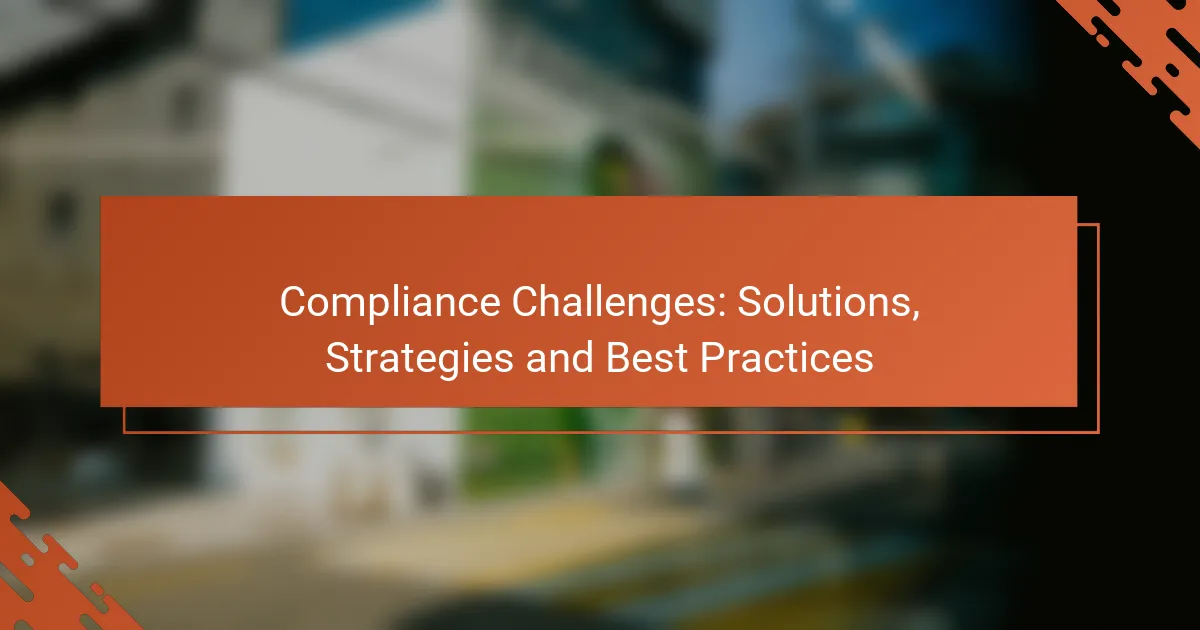Compliance challenges are a critical concern for businesses navigating complex legal and regulatory landscapes. Implementing effective solutions and strategies not only helps organizations adhere to these requirements but also fosters a culture of ethical standards and risk management. By establishing clear frameworks and maintaining open communication, companies can effectively mitigate risks associated with non-compliance and ensure operational efficiency.

What are the compliance solutions for businesses?
Compliance solutions for businesses include various tools and strategies designed to help organizations adhere to legal and regulatory requirements. These solutions streamline processes, reduce risks, and ensure that companies maintain ethical standards while operating efficiently.
Regulatory technology platforms
Regulatory technology platforms, or regtech, leverage technology to help businesses comply with regulations more effectively. These platforms automate compliance processes, monitor changes in regulations, and provide real-time reporting to ensure adherence. Companies can benefit from reduced manual effort and enhanced accuracy in compliance reporting.
When selecting a regtech solution, consider factors such as integration capabilities with existing systems, scalability, and user-friendliness. Popular platforms often include features like data analytics and risk assessment tools to enhance compliance management.
Compliance management software
Compliance management software centralizes compliance-related tasks, helping businesses track policies, procedures, and regulatory obligations. This software often includes features for document management, audit trails, and compliance reporting, making it easier to maintain compliance across various departments.
Look for software that offers customizable dashboards and alerts for upcoming deadlines or changes in regulations. A good compliance management system can save time and reduce the likelihood of non-compliance penalties.
Employee training programs
Employee training programs are essential for ensuring that staff understand compliance requirements and their roles in maintaining them. These programs should be tailored to the specific regulations relevant to the business and include regular updates as regulations change.
Effective training can involve a mix of online courses, workshops, and hands-on training sessions. Regular assessments can help gauge employee understanding and identify areas for improvement, ensuring that compliance knowledge is consistently reinforced.
Third-party audits
Third-party audits provide an independent assessment of a company’s compliance with regulations and internal policies. Engaging external auditors can offer valuable insights into potential compliance gaps and areas for improvement.
When selecting an auditing firm, consider their expertise in your industry and their familiarity with relevant regulations. Regular audits can help maintain compliance and build trust with stakeholders by demonstrating a commitment to ethical practices.
Risk assessment tools
Risk assessment tools help businesses identify, evaluate, and mitigate compliance risks. These tools can include software solutions that analyze data to pinpoint areas of vulnerability and suggest corrective actions.
Implementing a robust risk assessment process involves regularly reviewing compliance risks and updating strategies accordingly. Businesses should prioritize tools that allow for ongoing monitoring and reporting to stay ahead of potential compliance issues.
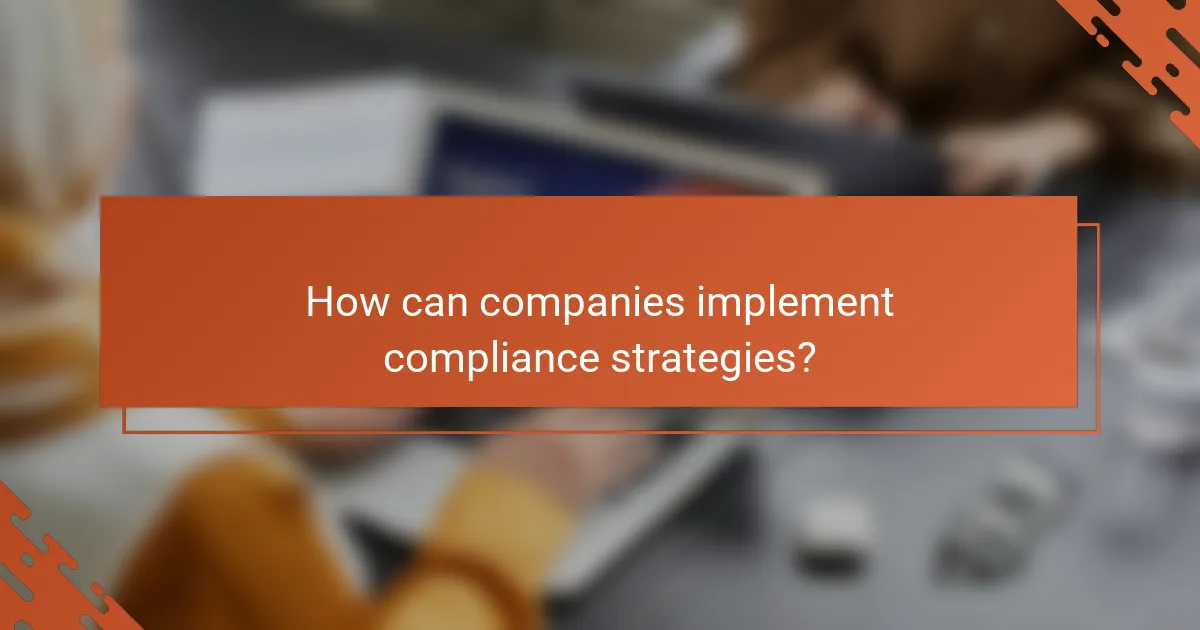
How can companies implement compliance strategies?
Companies can implement compliance strategies by establishing clear frameworks, conducting regular assessments, and fostering a culture that prioritizes compliance. These steps help ensure adherence to regulations and mitigate risks associated with non-compliance.
Developing a compliance framework
Creating a compliance framework involves defining policies and procedures that align with applicable laws and regulations. Companies should identify key compliance areas relevant to their industry, such as data protection, financial reporting, or workplace safety.
It’s beneficial to involve stakeholders from various departments to ensure comprehensive coverage. A well-structured framework should include documentation, training programs, and clear accountability measures to facilitate adherence.
Conducting regular compliance assessments
Regular compliance assessments are vital for identifying gaps and ensuring ongoing adherence to established policies. Companies should schedule these assessments at least annually, but more frequent evaluations can be beneficial, especially in rapidly changing regulatory environments.
During assessments, organizations should review processes, conduct audits, and gather feedback from employees. This proactive approach allows for timely adjustments and helps mitigate potential compliance risks before they escalate.
Integrating compliance into company culture
Integrating compliance into company culture requires leadership commitment and employee engagement. Leaders should model compliance behavior and communicate its importance through regular training and open discussions.
Encouraging employees to report compliance concerns without fear of retaliation fosters a transparent environment. Recognizing and rewarding compliance efforts can further reinforce its significance within the organization.
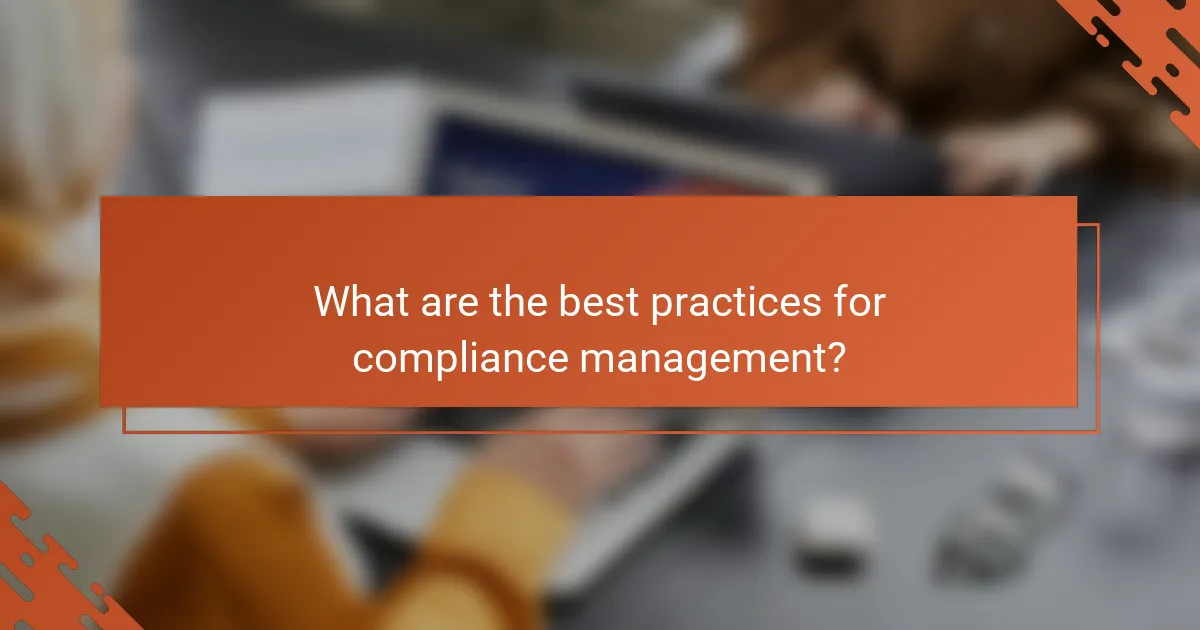
What are the best practices for compliance management?
The best practices for compliance management involve staying informed about regulations, maintaining open communication, and thoroughly documenting compliance processes. These strategies help organizations navigate complex legal landscapes and minimize risks associated with non-compliance.
Regular updates on regulations
Regular updates on regulations are crucial for effective compliance management. Organizations should establish a routine for monitoring changes in relevant laws and standards, which may vary by industry and region. Utilizing compliance software or subscribing to regulatory newsletters can aid in staying informed.
Consider setting up alerts for key regulatory changes that impact your business. This proactive approach allows for timely adjustments to policies and procedures, reducing the risk of violations.
Clear communication channels
Clear communication channels are essential for ensuring that all employees understand compliance requirements. Establishing a culture of transparency encourages staff to ask questions and report concerns without fear of repercussions. Regular training sessions and updates can reinforce the importance of compliance.
Utilize multiple communication platforms, such as emails, intranet postings, and team meetings, to disseminate compliance information effectively. This multi-channel approach helps reach all employees, regardless of their role or location.
Documenting compliance processes
Documenting compliance processes is vital for demonstrating adherence to regulations and facilitating audits. Organizations should maintain detailed records of compliance activities, including training sessions, policy updates, and risk assessments. This documentation serves as evidence of due diligence in case of regulatory scrutiny.
Implement a centralized documentation system to streamline access and updates. Regularly review and revise these documents to reflect current practices and regulations, ensuring they remain relevant and effective.
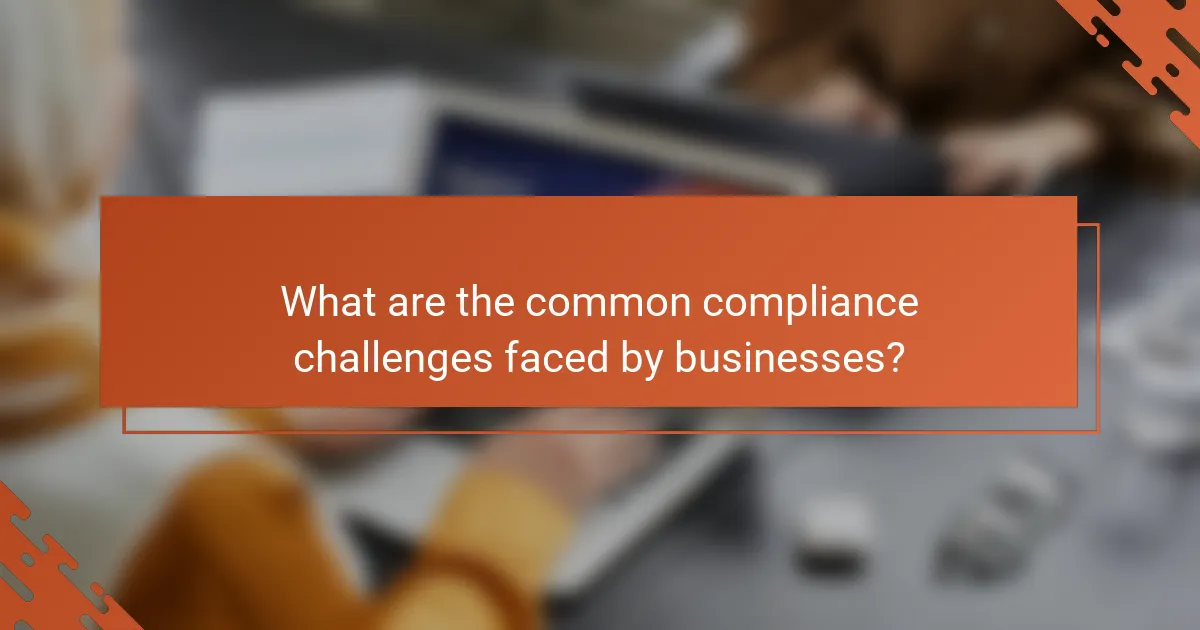
What are the common compliance challenges faced by businesses?
Businesses often encounter various compliance challenges, including adapting to regulatory changes, managing resources effectively, and ensuring employee engagement in compliance training. These issues can lead to increased operational risks and potential penalties if not addressed properly.
Keeping up with changing regulations
Staying updated with changing regulations is a significant challenge for many businesses. Regulations can shift frequently due to new laws, industry standards, or government policies, requiring companies to continuously monitor these changes.
To manage this, businesses should establish a compliance monitoring system that includes regular reviews of relevant regulations and updates. Utilizing compliance management software can also streamline this process, ensuring that all changes are documented and communicated effectively.
Resource allocation for compliance
Effective resource allocation is crucial for maintaining compliance without straining the organization’s budget. Companies often struggle to balance the costs associated with compliance activities against other operational needs.
To optimize resource allocation, businesses can conduct a cost-benefit analysis to identify the most critical compliance areas. Prioritizing high-risk compliance issues can help ensure that resources are directed where they are most needed, potentially reducing overall compliance costs.
Employee engagement and training
Engaging employees in compliance training is essential for fostering a culture of compliance within the organization. Many employees may view compliance training as a burden rather than a necessity, which can lead to gaps in understanding and adherence.
To enhance employee engagement, companies should implement interactive training programs that are relevant to their specific roles. Regularly scheduled training sessions, along with incentives for participation, can motivate employees to take compliance seriously and apply their knowledge in daily operations.
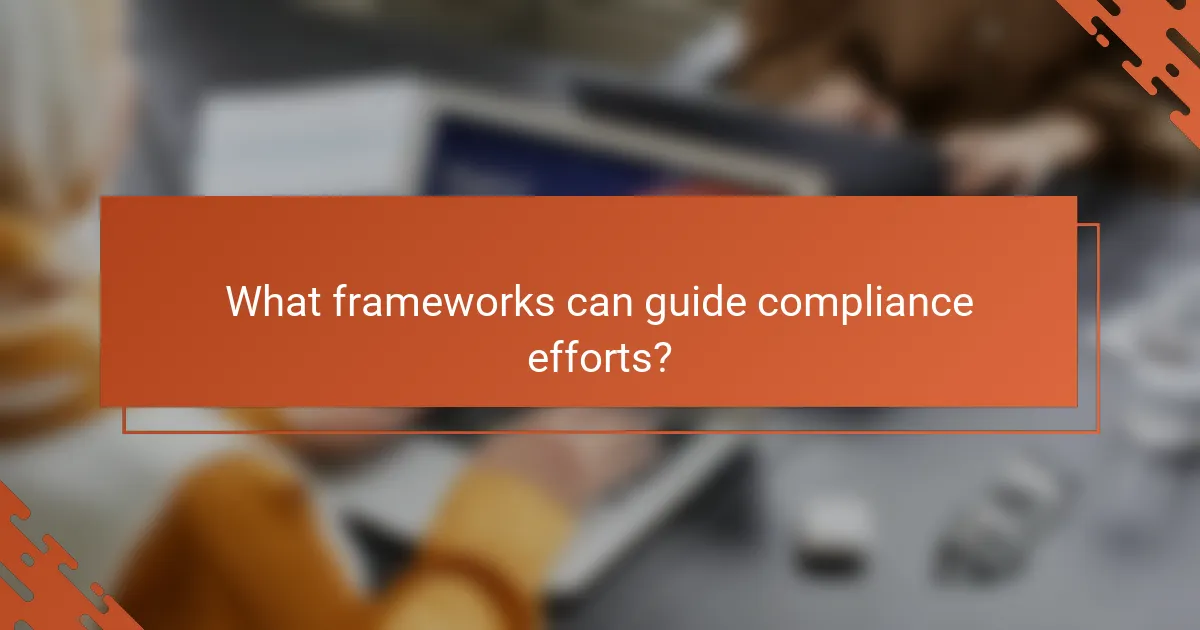
What frameworks can guide compliance efforts?
Compliance efforts can be effectively guided by established frameworks that provide structured approaches to managing regulatory requirements. These frameworks help organizations align their processes with legal standards, ensuring they meet obligations while minimizing risks.
ISO 19600 compliance framework
The ISO 19600 framework offers guidelines for establishing, developing, implementing, evaluating, maintaining, and improving an effective compliance management system. It emphasizes a risk-based approach, allowing organizations to identify compliance risks and address them proactively.
Key steps include defining compliance objectives, assessing risks, and establishing processes for monitoring and reporting. Organizations should ensure that their compliance culture is supported by leadership and integrated into daily operations.
Common pitfalls include neglecting employee training and failing to regularly review compliance processes. To avoid these, organizations should conduct regular audits and provide ongoing education to staff about compliance obligations.
COBIT for IT governance
COBIT (Control Objectives for Information and Related Technologies) is a framework designed to help organizations manage and govern their IT environments effectively. It aligns IT goals with business objectives, ensuring that compliance is integrated into IT governance practices.
Organizations should focus on defining clear governance objectives, assessing IT risks, and implementing controls that align with regulatory requirements. Regular performance evaluations and stakeholder engagement are crucial for maintaining compliance.
To maximize the benefits of COBIT, organizations should avoid siloed IT practices and ensure cross-departmental collaboration. This approach fosters a comprehensive understanding of compliance across the organization, enhancing overall governance and risk management.

How does compliance impact business operations?
Compliance significantly affects business operations by dictating how companies must conduct their activities to adhere to laws and regulations. This adherence can influence efficiency, costs, and overall organizational reputation.
Influence on operational efficiency
Compliance can streamline operational processes by establishing clear guidelines and standards. When businesses implement effective compliance measures, they often find that workflows become more organized, reducing redundancies and improving productivity.
However, compliance can also introduce complexity and additional costs. Companies may need to invest in training, technology, or personnel to meet regulatory requirements, which can temporarily slow down operations. Balancing compliance with efficiency is crucial for long-term success.
Effect on reputation and trust
Maintaining compliance is essential for building and sustaining trust with customers, partners, and stakeholders. A strong compliance record can enhance a company’s reputation, making it more attractive to potential clients and investors.
Conversely, non-compliance can lead to significant reputational damage, legal penalties, and loss of customer trust. Businesses should prioritize transparency and proactive communication about their compliance efforts to foster a positive image and mitigate risks associated with non-compliance.
